Sandia’s Distributed Energy Lab Marks FY15 Accomplishments, Adds New Capabilities
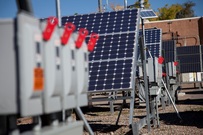
Sandia labs completed a number of enhancements to its Distributed Energy Technologies Laboratory (DETL) facility in 2015. Many of the updates
extend cyber-security capabilities at DETL, such as Sandia’s ability to
configure isolated networks for intrusion detection experiments. The communications-enabled
control overlay allows for comprehensive evaluation of cyber
vulnerabilities of distributed energy devices (DER) and controllers connected to the internet, fully leveraging Sandia's cybersecurity, controls, and high performance computing expertise. One application of this
infrastructure is to demonstrate the effect of cyber attacks and communication delays on large interconnected power networks using a combination of hardware and simulation (hardware-in-the-loop) for both power and communications networks. The Emulytics[TM] platform (i.e., SCEPTRE, MiniMega, and
Firewheel) enables high-fidelity emulation of communication networks of arbitrary size and
complexity. This new platform extends cyber-security capabilities for
Sandia by facilitating integration with physical DERs at DETL. POC: Jay Johnson
|
Sandia Labs conducts PV research as part of ARPA-e MOSAIC program
Massachusetts Institute of
Technology and Sandia National Laboratories have initiated a collaboration on
Wafer-Level Integrated Concentrating Photovoltaics that reduces the complexity
of tracking needs. The team’s innovative approach uses wafer-level
micro-concentrators to significantly enhance sunlight concentration onto high-performance
III-V micro-PV cells (pictured). The concentrator
is also a diffuse solar radiation collector, allowing the technology to operate
in regions with high levels of diffuse sunlight. The team will use standard
semiconductor processes to fabricate the system, ensuring high-precision, yet
low-cost manufacturing. The Wafer-Level Integrated Concentrating Photovoltaics
is one of 11 projects funded by ARPA-e under the Micro-scale Optimized
Solar-cell Arrays with Integrated Concentration (MOSAIC) program. The
project also builds upon Sandia’s prior work in the microsystems-enabled
photovoltaics (MEPV) Grand Challenge.
The MOSAIC program focuses on the design of technologies and concepts
for a new class of cost-effective, high-performance micro-scale concentrating
PV (micro-CPV) technologies integrated
into “flat plate” solar panels to improve their efficiency and cost. This
micro-CPV approach addresses the constraints of conventional CPV, which, while
highly efficient, has not been widely adopted due to its high cost, large size,
and expensive solar tracking systems. Project teams will address these
limitations by developing innovative materials, micro-scale manufacturing techniques,
panel architectures, and tracking schemes. The MOSAIC program also includes a
Small Business Innovation Research (SBIR) award category. POC:
Anna Tauke-Pedretti
Image above shows a PV II-V cell with 250 µm diameter optical aperture
|
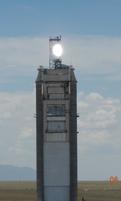 Sandia’s Continuously Recirculating Falling-Particle Receiver Placed Atop
of the Solar Tower
Sandia began first-of-its-kind testing using its continuously
recirculating falling-particle receiver atop the National Solar
Thermal Test Facility
(NSTTF). The falling-particle receiver drops sand-like ceramic particles
through NSTTF’s concentrated sunlight beam, capturing and storing the heated
particles in an insulated tank. Compared to conventional molten-salt systems,
the falling particle receiver creates more available energy and cheaper storage
costs with less material needed for heat transfer. Sandia’s goal is to
develop a prototype, cost-competitive falling-particle receiver with the
potential for thermal efficiency greater than 90% and particle temperatures of
at least 700°C. POC: Subhash L. Shinde
|
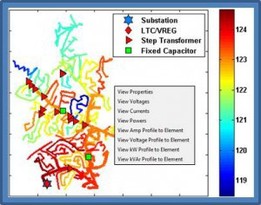 GridPV Toolbox Version 2 Now Available
The GridPV toolbox models and simulates the integration of
the distributed, or local, power generation into the electric power system.
Simulations with this tool can be used to evaluate the impact of solar energy
on the distribution system.
GridPV Toolbox is a fully-documented set of Matlab functions that can
be used to build distribution grid performance models using the open source
distribution modeling tool OpenDSS. The GridPV functions are useful
for interfacing OpenDSS and Matlab to perform sophisticated analyses and graphically
representing information from simulations. A set of
functions is also included for modeling PV plant output in the OpenDSS simulation. The toolbox contains functions for overlaying distribution feeders on satellite images using GPS coordinates.
GridPV version 2 was recently upgraded to include the
following new features:
-
Updated MATLAB help menus for GridPV and a new user manual,
including 20 new pages of documentation
-
Updated to use new OpenDSS System object
-
Uses the newest Sandia Wavelet Variability Model (WVM) for PV
modeling
-
25 new plotting features and functions
The documentation and toolbox are available for public download. POC Robert Broderick (6112). Image above shows an example GridPV graphic of a feeder voltage profile by
line segment.
|
Largest Reduction of Solar Energy in 24 Years Recorded at the PSEL Linked
to El Niño
Since before 1990, Sandia’s
Photovoltaic (PV) System Evaluation Lab (PSEL) has been comprehensively
recording solar irradiance data to accompany
its outdoor PV testing. The unusual dip in 2015 solar energy at the facility
prompted us to notice that other historic dips in the sun’s insolation, or the
amount of sunlight shining on the earth, have coincided with the larger El Niño
years. Prior to 2015-16, intense El
Niño conditions occurred in
1991-92, 1997-98, 2004-05, 2009-10. Many smaller events are harder to detect
and, to be fair, climatic changes in 1992 were mainly attributed to the
eruption of Mt. Pinatubo. The current weather data at the PSEL along with a
link to a summary of the historic data can be found on Sandia Labs' PV website. POC: William Boyson
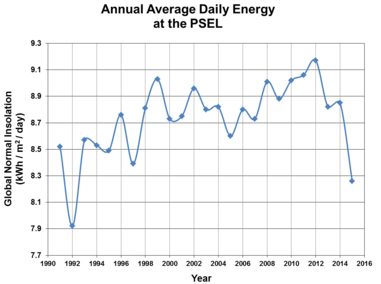 Annual average daily energy at Sandia Labs' PSEL
Sandia Labs Releases
New Version of PVLib Toolbox
Sandia has released version 1.3 of PVLib, its
widely used Matlab toolbox for modeling photovoltaic power systems. The
version 1.3 release includes the following added functions:
- functions to estimate parameters for popular PV module
models, including PVsyst and the CEC ‘5 parameter’ model
- a new model of the effects of solar spectrum on PV
module current
- code to access weather data from NOAA’s Integrated
Surface Data network
PVLib version 1.3 can be downloaded for free at pvpmc.org and
is released under an open source software license. POC: Josh Stein.
Sandia Labs Releases Wavelet Variability Model (WVM)
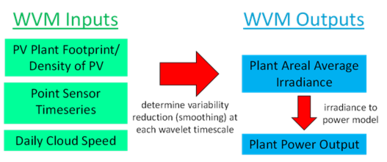
When a single solar photovoltaic (PV) module
is in full sunlight, then is shaded by a cloud, and is back in full sunlight in
a matter of seconds, a sharp dip then increase in power output will result.
However, over an entire PV plant, clouds will often uncover some modules even
as they cover others, resulting in only small changes in plant power output.
Thus, the power output of a PV plant is smoother than the power output of a
single module. Sandia has published the Wavelet Variability Model (WVM), implemented in Matlab, to model
the spatial smoothing of irradiance over a PV plant or neighborhood with
distributed PV. The WVM release includes a readme file with details on use of
the WVM function and examples showing the WVM function applied to simulate both
central and distributed PV. POC: Matt Lave
|
Sandia Defines Solar Variability Zones
Sandia has defined solar variability zones by modeling solar
variability across the country using a combination of ground measured and
satellite derived solar irradiance measurements. The zones represent the
magnitude of high-frequency (sub-minute) solar variability—changes in available
sunlight—at each location. PV installations in locations with higher solar
variability can, all else being equal, lead to larger voltage fluctuations on
electric distribution grids than PV installations in areas of low solar
variability. Thus, to understand and study the impact of PV installations in a
specific location to distribution grid operations, it is important to know the
solar variability at that location. To facilitate such studies, solar
variability samples from each zone are available. POC: Matt Lave
|

NREL and Sandia host PV Module Reliability Workshop, Feb. 23-25, 2016
The
National Renewable Energy Laboratory (NREL) and Sandia National Laboratories
are jointly organizing the annual PV
Module Reliability Workshop. This year’s event, to be held February 23-25, 2016, in
Lakewood, CO, will bring
together photovoltaics (PV) experts from national laboratories, industry, and academia to discuss the most recent
updates in photovoltaic system reliability and lifetime. Dr. Olga Lavrova will
be chairing the PV systems and inverter
reliability session. Advanced sign-up for the workshop is highly encouraged as
we typically reach capacity and walk-in registrations will not be accepted.
POC: Olga Lavrova
Sandia and EPRI to Host PV Symposium in May 2016
Sandia National Laboratories and the Electric Power Research
Institute (EPRI) are pleased to host the third PV Systems Symposium, May 9-12,
2016, at the Biltmore Hotel in Santa Clara, CA, on technical issues related to
PV systems and technologies. Core areas of focus will include PV performance
modeling, distribution hosting capacity and screening methods, component
reliability, as well as data-driven strategies for performing economically
efficient system upkeep. POC: Josh Stein
|
External Link Disclaimer: The appearance of hyperlinks does not constitute endorsement of the external Web site, the information, products or services contained therein.
|